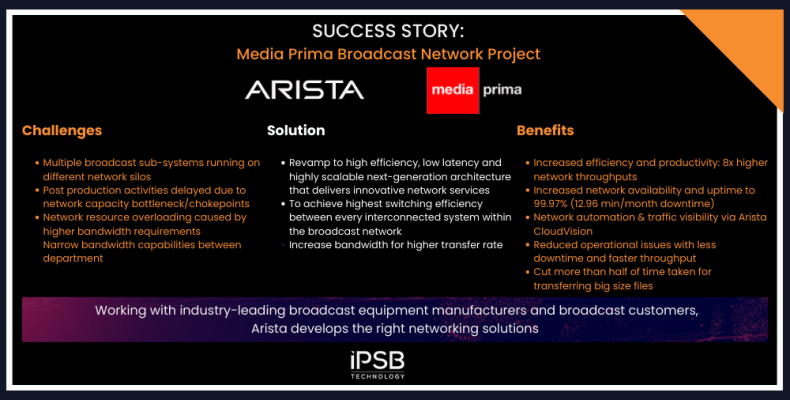Executive Summary
IPSB Technology along with its technology partner Arista Networks transformed Media Prima Berhad’s broadcast network architecture. This resulted in a streamlined workflow and provision of quality broadcast to satisfy its growing customers.
Media Prima Berhad is Malaysia’s largest integrated media group with over 28 million viewers. In 2016, Media Prima announced new content and initiatives to ensure a continued leadership position in all genres. It was targeting audience of Chinese and Malay and new services aimed at the local digital landscape. Their goal is to leverage media differences to offer presentations and solutions that are interactive and immersive.
Media Prima Berhad has surpassed Google and Facebook as the most popular choice for mobile content among Malaysians. Data from US-based media measurement and analytics company Comscore Mobile Metrix Top 100 Properties, Total Audience, Dec 2018, Malaysia. Media Prima tops the list with 13.60 million total unique visitors, a 62% increase from December 2017. This was followed by Google Sites with 12.95 million, and Facebook with 12.92 million. This underscores the success of the Group’s transformation efforts to become Malaysia’s leading digital-first content and commerce company.
Media Prima started promoting the Internet’s reach to strengthen brand loyalty and provide quality broadcasting services to consumers. Media Prima requires high-capacity and streamlined networking to handle the broadcast environment and work arrangements in each department. To reduce media file transfer time between Media Prima Network user/system and broadcast system, eliminate or minimizes network latency and bottlenecks as well as increase port density potential, Media Prima has taken initiatives to upgrade their broadcasting network due to high demand of file transfer rate and large file size for media transfer. As this broadcast network is established and integrated, it successfully shortens transfer time for media to 10 Gigabytes file successfully transferred in less than 2 minutes.
Overview – The Quick Pitch
- The existing file transfer time for 10GB file size, took 15 minutes to complete . The implementation of the broadcast network reduced it to 2 minutes for the 10GB file size. To reduce media file transfer time between Media Prima Network user/system and broadcast system, eliminate or minimizes network latency and bottlenecks as well as increase port density potential.
The Problem
- The mix of brands such as Avaya, Dell, and HP was evident in the existing network infrastructure. The mix to the Broadcast System led to the difficulty of equipment management.
- The bandwidth for existing broadcast networks is not fully capable of handling the demanding transfer rate for media files.
- Too many layers of network and mixed VLAN segment has caused high latency that impact overall broadcast system performance
- Existing network switches are already at the end of life and are not ready for the Media Prima future project.
The Solutions
- As one of IPSB technology partners, Arista Networks which is a leader in building scalable, high-performance and ultra-low latency cloud networks with low power consumption and a small footprint for modern data centre and campus environments. IPSB is working together with Arista to establish each switch to have 48 access ports of 1/10GbE, and 4 ports of 40G/100G backbone for uplink.
- By introducing spine & leaf network architecture, it allows data flows to take shortcuts from where data is, to where it is going. Layer 3 data flows within traditional three-tier architectures can vary. This depends on where the source and destination devices reside on a network.
- As Malaysia’s No. 1 integrated media group, Media Prima took the early steps by updating their network system that is able to handle 4x100Gbps bandwidth if needed at any time to meet the “future-ready” aspirations, in preparation for the future.
The Highlights
- The uplink works using 4 ports of 40G backbone switch which makes the company’s network system more efficient, organized and well facilitated.
- This broadcast network upgrades auspiciously shorten transfer time for media which recorded a 10Gigabytes file successfully transferred in less than 2 minutes.
- By upgrading the broadcast network, it simplifies and differentiates network segments between the user and system environment.

